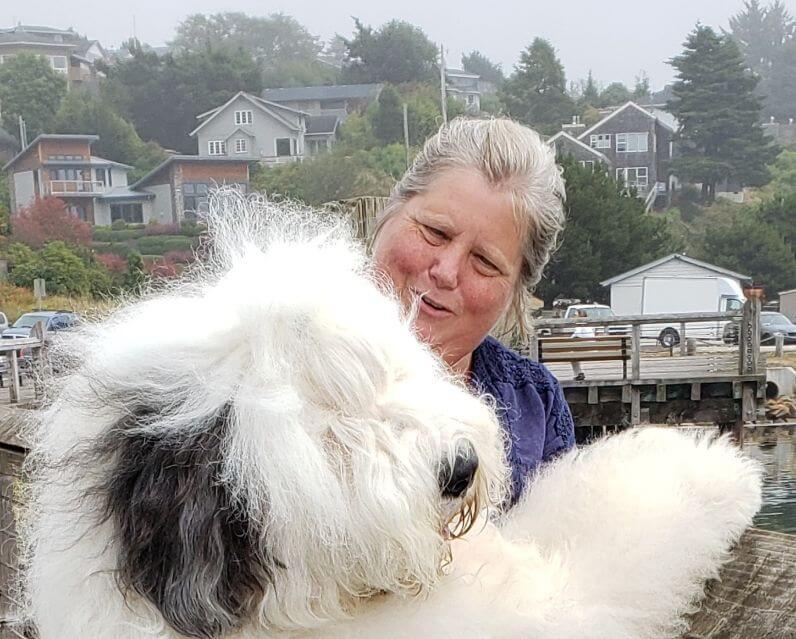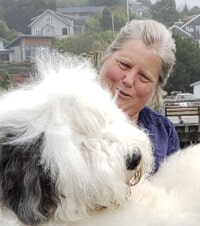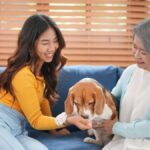Interview with Herding Group Breeder Lita Long
Where do I live? How many years in dogs? How many years as a breeder?
Lita Long: We live in Oregon. (All of my life for 64 years.) While I was involved with my mother who founded our kennel, I whelped my first litter in 1972 and bred my first litter on paper in 1980.
What is my kennel name? How many dogs do I currently keep?
Lita Long: Our kennel name is Blue Panda Reg. It was established in 1963 by my mother, Dianne McKee-Rowland, with our first Old English Sheepdog (OES) Ch. Polar Paw Blue Panda. We are now on our 10th generation that can be traced back to her.
Which show dogs from the past have been my noteworthy winners?
Lita Long: Noteworthy winners include: Am. & Can. Ch. Blue Panda Party Doll, Am. & Can. Ch. Blue Panda Snow Knight (BISS), Am. & Can. Ch. Trosambe Blue Panda St. Owly CDX Can UD (Best in Show Winner in both countries), Am. & Can. Ch. Trosambe Blue Panda Shawn, Am. & Can. CD (Best in Show in Canada), Am. Ch. Trosambe Blue Panda Smuggler CD, Am. Ch. Blue Panda Snow Wizard, Am. & Can. Ch. Blue Panda Desert Dreamer (BIS & BISS), Am. Ch. Blue Panda Kissing Bandit CD RN CGC, Am. Ch. Blue Panda Artiaus CD RN CGC, Bog GCH Blue Panda Azulado Multiple (BIS), Bog GCH Blue Panda Highway to the Stars at Azuloso (Multiple BIS), and GCHS Lorien The Portrait.
Which have been my most influential sires and dams?
Lita Long: Influential sires and dams include: Am. & Can. Ch. Blue Panda Party Doll, Am. & Can. Ch. Blue Panda Snow Knight (BISS), Am. & Can. Ch. Trosambe Blue Panda St. Owly CDX Can UD (Best in Show Winner in both countries), Am. & Can. Ch. Blue Panda Desert Dreamer (BIS & BISS), Am. Ch. Blue Panda Pure Basic Beauty CD RN, Am. Ch. Blue Panda Bracken’s Timbre, Am. Ch. Blue Panda Pure Basic Bobtale RN, Am. Ch. Blue Panda Kissing Bandit CD RN CGC, and Am. Ch. Blue Panda Artiaus CD RN CGC.
Can I talk a bit about my facilities? Where are my puppies whelped? How are they raised?
Lita Long: All of our puppies have been raised in our front rooms. We love the plastic kiddy pools; they are so very movable and easy to clean. The puppies have all been raised with ENS and Puppy Culture protocols since the early 1970s when an article, “Show Dogs Are Raised, Not Just Born” came out. Breeders cannot do enough to set their puppies up for success. This is our goal and what we send our puppies home with. We love hearing about how stable and solid the puppies are when they arrive at their new homes.
What is my “process” for selecting show puppies? At what age do I make my decisions?
Lita Long: At birth and in the whelping box, we look at head shape and body length. We watch how they push off nursing with the front feet and how they push with the back feet, and we look for a nice arch of neck. At four weeks, we take pictures of heads; looking for the classic bobtail head shape, boxy bodies, and how the legs “hang.” At seven to eight weeks, we microchip, do vet checks, ears and eyes, and then we make final calls to prospective owners and give notice to those who made the cut for show or pet homes. We match the puppies’ personalities with what the new owners have told us about their expectations. It does no good to sell a Frisbee dog to someone who wants a couch potato. We have found that what we see at four weeks, we will see for the life of the dog. I often wish that my brain could print out all I see in a puppy; the mental notes would create a volume of comments.
How do I prepare my pups for the show ring? Does my breed require any special preparation?
Lita Long: Grooming, Grooming, Grooming. Old English Sheepdog are NOT a baiting breed, and their coat must be maintained. They require hours on the table. Being introduced to playing “flat dog” on the table at four weeks takes the scare out of it. Being bathed gently, followed by an introduction to the dryer and learning that the grooming table is a great place for attention, is always “a plus” that we consider of paramount importance. All great OES owners will die with a brush in their hands. (It will still be moving after rigor mortis has set in!)
Is my breed hand-stacked or free-stacked in the show ring? Why is it presented in this manner?
Lita Long: OES are hand-stacked. They have a lot of hair, and it does not stay in place. In fact, it has a mind of its own (no matter how much “foreign substances” we put on it). Baiting an OES takes away that arch of neck, because with all that hair they have to throw their heads back to see the bait. Most of those showing the breed today dislike the Bichon look on the head. Nothing drives me batty more than a judge trying to bait the breed on the down and back. The judge should ask for the fall to be lifted so that he can see the face if he wants to see expression. OES are a square breed and should never resemble any other breed while standing. A well-set dog shows power and stature to do the jobs they were bred to do.
Are Performance and Companion titles important to me as a breeder? Are parent club titles?
Lita Long: YES. As you can see from the list of notables, many of our dogs have titles at both ends. Our first did so in 1976. To date, we have over 40 dual-titled dogs. Ch. Trosambe Blue Panda St. Owly won BIS the same day that he competed in Open Obedience. We have finished several dogs’ CH and CD titles on the same day. In the OES parent club, there are not a lot of titles. Our “ROM” Register of Merit is only based on champions produced and nothing else. There is no recognition at this time for the accomplishments of offspring in performance.
In my opinion, is my breed in good condition overall? Any trends that warrant concern?
Lita Long: No, not really. We have a big generation gap between the “40 Years-Plus” breeders and the “Under 15 Years” breeders. The Internet has done a lot to disrupt the natural order of breeder education in all breeds, which has been the tried-and-true method of mentorship. In any breed, the newbies to breeding seem to be putting too much emphasis on winning ribbons. Ribbons do nothing in the whelping box. Unless they have grown up in their breed, they have never heard the stories around the ex-pen at the end of the show day. The high speed of the sport has not given enough to the memories that are being lost about dogs. Again, think mentorship. It is my hope that maybe we can save some of that information before all is lost.
With the push for health testing, and with breeder responsibility being at the forefront of today’s breeder, the overall health of OES is on pretty good footing. However, the value of what we have seen, what we know, and what we can share is being lost. To the newbies, I could ask, “When was the last time you sat down and asked your breeder, ‘Who were the dogs you wish you had bred and why?’” Or maybe, “What would your dream mating have been?” These answers should be your goals to accomplish. Learn pedigrees. Learn dogs by photographs and, better yet, by hands-on. And above all, KNOW THE NAMES OF THE BREEDERS WHO MADE YOUR BREED. Of the utmost importance is the determination not to count on a pretty picture but on a “bred to the standard” dog under that creation. No pair of scissors will help you in the whelping box.
Is my breed well-suited to be a family dog? Who are the best candidates to own my breed?
Lita Long: Ninety percent of this breed are dependable and are consistent in nature. It is the other ten percent that think they can “rule the house” if allowed. This breed was notable for taking the stock back home when the shepherd was tippling too much at the pub. It was those dogs that knew what to do and when to do it. OES like their world in order, and if it is not, they will then strive to make it so—sometimes not in the best of ways.
We prefer to place pet puppies in experienced homes and get newbies to the breed to work with us on a show dog. The main reason is so that they can learn how to care for, train, and groom the breed to the best of their ability. It drives us nuts when breeders are not doing their due diligence, and newbies to the breed think that everyone but that breeder knows more. Ask your breeder first, with the expectation of paying attention.
Do I feel that my breed is supported by a sufficient number of preservation breeders?
Lita Long: Tired Preservation Breeders? Yes. Frustrated Preservation Breeders? Yes, to the max! Newbies? That’s a big NO.
Understanding what it takes to preserve a breed is a long lesson, and when newbies breed their first litter they better have made the choice which way they are going to go. All breeding should be planned with a three-generation plan in place. Learn what it takes to create a line so that when you have a puppy far away, people will say, “I know who bred that puppy” before the catalog is ever opened.
For a bit of fun, what’s the most amusing thing I’ve ever experienced with a Herding Dog?
Lita Long: A few thoughts: In OES, their creativity is to “reinvent the wheel.” Normal is not in the vocabulary of the breed. Laugh at their antics and plan on living with it forever. “Herding” is a big word and encompasses a lot of things for the breed to do. When the flock is all in place, then their world is “good.” Where there is a will, there is a way, be it walking along a line of grooming tables to get where they want to be, or entertaining themselves in play. Some of ours play tether-ball with each other. Most amusing is their “selective deafness” while looking directly at you!
Anything else I would like to share about myself? Any special message I may have for all of us in the fancy? Where to start?
Lita Long: Having spent my life in the breed—no prom. (There was a dog show that weekend.) I have traveled to places, met people from all walks of life, and done many things that I doubt I would ever have done without my life in the dogs. I have shared a love of the breed and will still do so with the people I meet in the future. I have stood in front of a large room of people to share and educate them on the breed, and the sport of dogs, and to share experiences with newbies. I have been a mentor to others about dogs in general. I like to learn how dogs tick. (This never stops.) I tell people in my Obedience Classes, “I have a Dog Training Tool Chest and I am sharing it with you.” We always tell our owners, “No question is stupid, so do not be afraid to ask it.” My message to new breeders: “It is important to not try to reinvent the wheel. First learn how it was invented.” It has served a purpose, and always keep that purpose in mind. The whelping box is not where the ribbons are won. “It is because of the whelping box that ribbons are won”
It is because of the sport of dogs that I have had the opportunities to grow a love for the sport. There is never a show that I go to where I will not run into an old friend. It is important, whether texting, emailing or actually talking on the phone to a new OES owner, that we do it with a smile and an open mind. The world around us is changing by the hour and it is impossible to keep up. Frankly, it is enough that I can “dog paddle” at the best of times.
Thank you, Showsight, for the opportunity to put out to so many our words of wisdom and to just touch a bit on a breeder’s mindset. Education is key. For instance, not many know that OES are not only herders but are also bird dogs, cart dogs, and sled dogs—as well as bed dogs.
On a final note, I would ask anyone who is inquiring about owning an OES if they would be willing to clean its shaggy (******) backside at all hours. Dogs that we have bred, owned or shown have found us willing to do so, no matter the hour. Keep that brushing arm strong. Brush, brush, brush!









